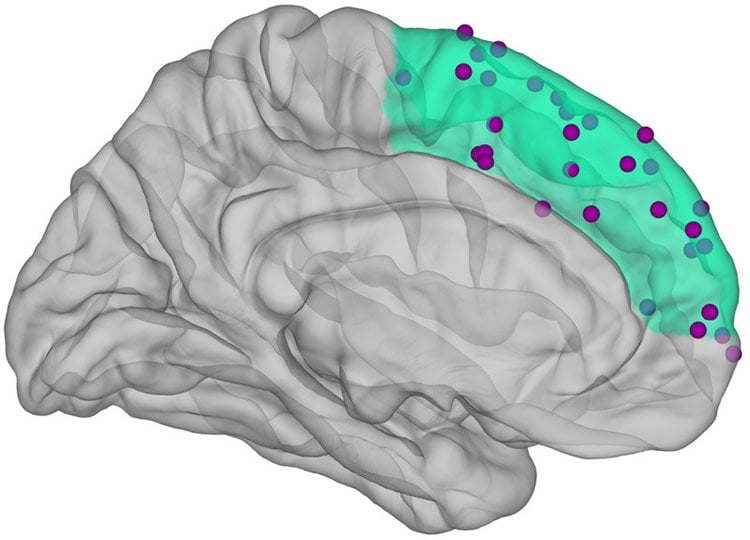Summary: Researchers report the medial prefrontal cortex calibrates current visual information with previously obtained information to help us perceive the world with more stability, helping to retain visual consistency as we blink.
Source: DPZ.
Every five seconds we close our eyes and blink to moisten them. During this brief moment no light falls on our retina yet it is not constantly dark and we continue to observe a stable picture of our environment. The brain seems to remember the percepts that have just happened. Caspar Schwiedrzik and Sandrin Sudmann, neuroscientists at the German Primate Center and the University Medical Center Göttingen, have in cooperation with colleagues from the United States performed studies on epilepsy patients to determine where this memory is situated in the brain and how it works. They have identified a brain area that plays a crucial role in perceptual memory. This finding enables a better understanding of the interaction of perception and memory.
Even though we constantly blink and move our head and eyes, we still see our world as a stable, unified whole. It must therefore be possible for the brain to retain visual information for a short period of time and then put it together to form a conclusive image without interruptions. Caspar Schwiedrzik and his team of neuroscientists suspected that a specific brain region known as the medial prefrontal cortex which plays an important role in short-term memory and decision-making may be a key player in this process.
At New York University the scientists had the opportunity to study this region of the brain in patients with epilepsy. To treat their disease, electrodes were temporarily implanted in the brain of these patients. Subjects were shown a dot lattice on a screen and were asked to indicate their perception of the orientation (for example horizontal or vertical) of the points. They were then shown a second dot lattice and were asked to indicate the orientation of the points. If both orientations were the same, this was interpreted as an indication that the subjects used the information from the first round to establish a conclusive percept in the second round. While the subjects performed the task, their neural activity in the prefrontal cortex was recorded. In one of the subjects a section of the superior frontal gyrus was removed due to an earlier illness and she was unable to store the visual information.

“Our research shows that the medial prefrontal cortex calibrates current visual information with previously obtained information and thus enables us to perceive the world with more stability, even when we briefly close our eyes to blink,” says Caspar Schwiedrzik, first author of the study and scientists at the German Primate Center and at the University Medical Center Göttingen. This is not only true for blinking but also for higher cognitive functions. “Even when we see a facial expression, this information influences the perception of the expression on the next face that we look at,” says Schwiedrzik.
“We were able to show that the prefrontal cortex plays an important role in perception and in context-dependent behavior,” says Schwiedrzik, summarizing the findings of the study. In further studies, the researchers want to investigate, among other things, the role that confidence in one’s own perception plays in perceptual memory.
Source: DPZ
Publisher: Organized by NeuroscienceNews.com.
Image Source: NeuroscienceNews.com image is credited to Caspar M. Schwiedrzik.
Original Research: Abstract for “Medial prefrontal cortex supports perceptual memory” by Caspar M. Schwiedrzik, Sandrin S. Sudmann, Thomas Thesen, Xiuyuan Wang, David M. Groppe, Pierre Mégevand, Werner Doyle, Ashesh D. Mehta, Orrin Devinsky, and Lucia Melloni in Current Biology. Published September 24 2018.
doi:10.1016/j.cub.2018.07.066
[cbtabs][cbtab title=”MLA”]DPZ”Why it Doesn’t Go Dark When You Blink.” NeuroscienceNews. NeuroscienceNews, 25 September 2018.
<https://neurosciencenews.com/blinking-darkness-9908/>.[/cbtab][cbtab title=”APA”]DPZ(2018, September 25). Why it Doesn’t Go Dark When You Blink. NeuroscienceNews. Retrieved September 25, 2018 from https://neurosciencenews.com/blinking-darkness-9908/[/cbtab][cbtab title=”Chicago”]DPZ”Why it Doesn’t Go Dark When You Blink.” https://neurosciencenews.com/blinking-darkness-9908/ (accessed September 25, 2018).[/cbtab][/cbtabs]
Abstract
Medial prefrontal cortex supports perceptual memory
Our visual environment constantly changes, yet we experience the world as a stable, unified whole. How is this stability achieved? It has been proposed that the brain preserves an implicit perceptual memory in sensory cortices which stabilizes perception towards previously experienced states. The role of higher-order areas, especially prefrontal cortex (PFC), in perceptual memory is less explored. Because PFC exhibits long neural time constants, invariance properties, and large receptive fields which may stabilize perception against time-varying inputs, it seems particularly suited to implement perceptual memory. Support for this idea comes from a neuroimaging study reporting that dorsomedial PFC (dmPFC) correlates with perceptual memory. But dmPFC also participates in decision making, so its contribution to perceptual memory could arise on a post-perceptual, decisional level. To determine which role, if any, PFC plays in perceptual memory, we obtained direct intracranial recordings in six epilepsy patients while they performed sequential orientation judgements on ambiguous stimuli known to elicit perceptual memory. We found that dmPFC activity in the high gamma frequency band (HGB, 70–150 Hz) correlates with perceptual memory. This effect is anatomically specific to dmPFC and functionally specific for memories of preceding percepts. Further, dmPFC appears to play a causal role, as a patient with a lesion in this area showed impaired perceptual memory. Thus, dmPFC integrates current sensory information with prior percepts, stabilizing visual experience against the perpetual variability of our surroundings.






